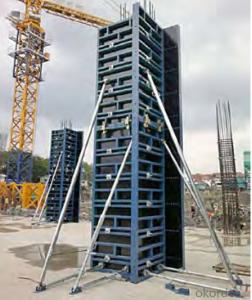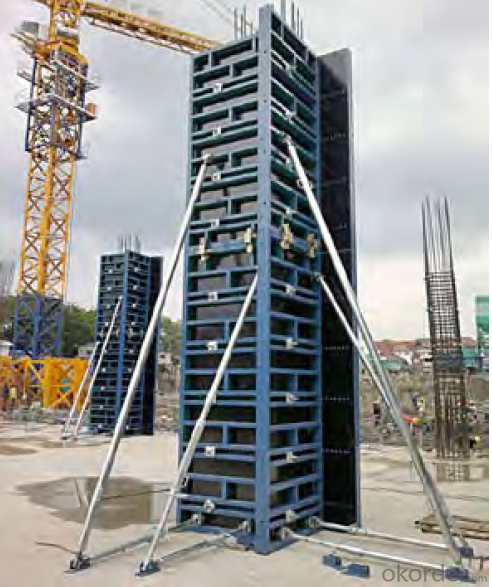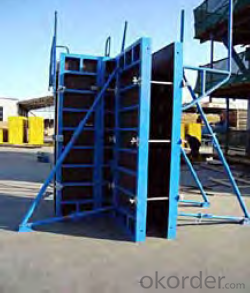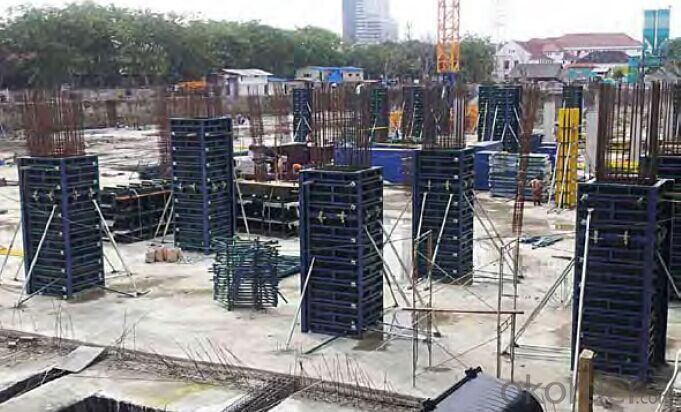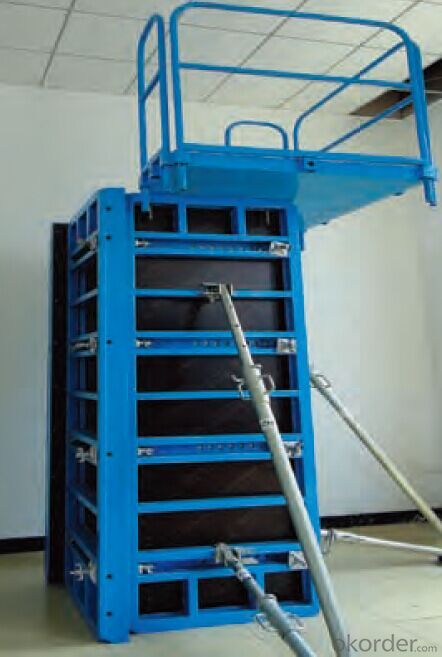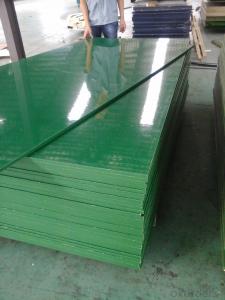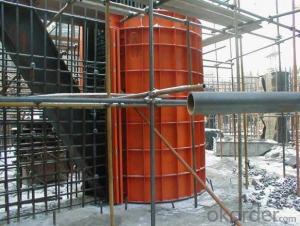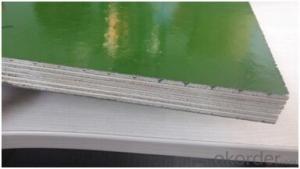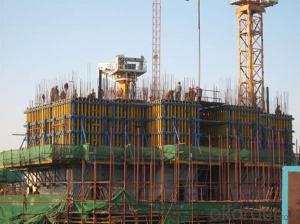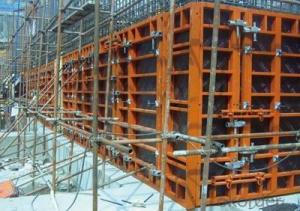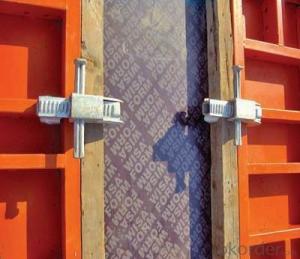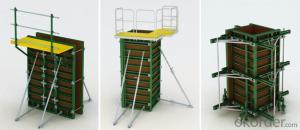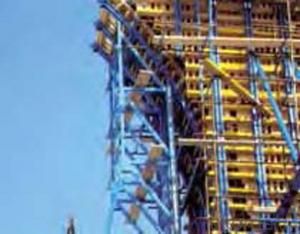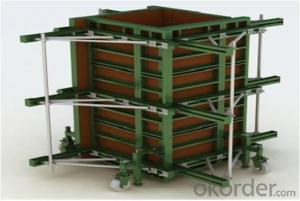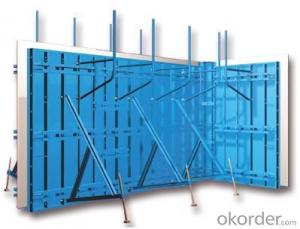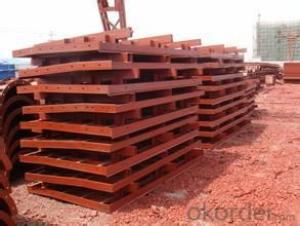Steel Frame Formwork with High Quality and Strong Competitive in Construction
- Loading Port:
- Shanghai
- Payment Terms:
- TT OR LC
- Min Order Qty:
- 1 m²
- Supply Capability:
- 100000000 m²/month
OKorder Service Pledge
OKorder Financial Service
You Might Also Like
1. Structure of Steel Frame Formwork GK120
There is a prizing part designed in the corner, which can help to position and remove formwork easily.The plywood is screwed on from the back when connecting frame and plywood, so the surface of the finished concrete is perfect.The formwork series are a complete system with a full set of accessories, and can be set up flexibly according to project demand.As the formwork,it is adapted to the plywood with thickness of 18mm.High-precision production line guarantees the perfect products.
2. Main Features of Steel Frame Formwork GK120
Light weight
High strength
Easy connection with adjustable steel clamp
Convenient and fast corner formwork
Flexible to assemble and application
3. Steel Frame Formwork GK120 Images
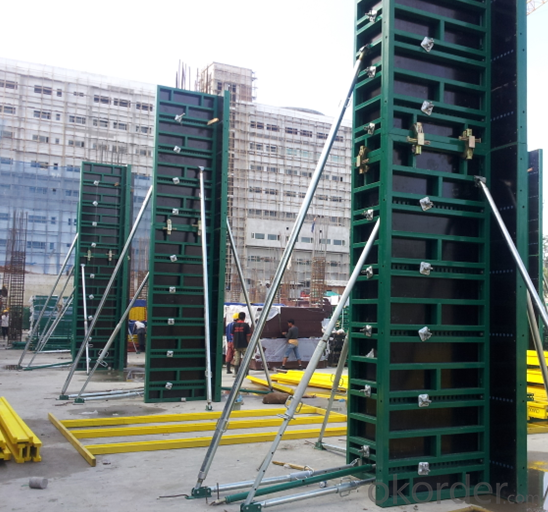
4. Steel Frame Formwork GK120 Specification
-Steel Frame Formwork GK120 is used for the concrete pouring of square or rectangle column. The system has the same structure and similar connection type with wall formwork.
-The frame is highly strengthened, and the wall formwork can bear lateral pressure 60 KN/m2 while the column formwork can bear 80 KN/m2.
-As a standardized system, it is flexible to assemble , wood batten can be filled to satisfy the need f of non-standard size.
-The adjustable steel clamp is convenient to use, and can hold tightly.
-The plywood is screwed on from the back when connecting frame and plywood, so the surface of the finished concrete is perfect.
5. FAQ of Steel Frame Formwork GK120
1) What can we do for you?
.We can ensure the quality of the vinyl banner and avoid extra expenses for customers.
.We can provide you the professional design team.
.We can provide fashionable and newest styles for you.
.We can design the artwork for you.
2) What promises can be done by us?
. If interested in Steel Frame Formwork GK120, please feel free to write us for any QUOTE.
. Please DO check goods when courier knocks your door and contact us asap if any issue.
3) What about of our after-sale service?
. Response will be carried out in 24hours after receiving any complain or request.
. Steel Frame Formwork GK120 cost can be refund after order is confirmed.
4) What about the package and shipping time?
.Packing: As Customer's Requirements
.Shipping: We have various shipping ways for our customers
.Shipping time:
Normally small orders, it just 10-15 business days to arrive your hand; When comes to the customs declaration, it may need 7 days.
- Q: Can steel frame formwork be used in areas with high temperature variations?
- Yes, steel frame formwork can be used in areas with high temperature variations. Steel is known for its durability and strength, making it suitable for use in various weather conditions, including areas with significant temperature fluctuations. Unlike other materials, steel does not expand or contract significantly with changes in temperature, ensuring the formwork remains stable and intact. This characteristic makes steel frame formwork an excellent choice for construction projects in regions with extreme temperature variations. Additionally, steel formwork is resistant to warping, cracking, or deforming, further enhancing its suitability for high-temperature environments.
- Q: How does steel frame formwork accommodate for different concrete finishing requirements?
- Steel frame formwork is a versatile and adaptable solution that can easily accommodate different concrete finishing requirements. One of the main advantages of steel frame formwork is its ability to be adjusted and modified, allowing for precise control over the shape, size, and texture of the final concrete structure. To accommodate for different concrete finishing requirements, steel frame formwork offers various customization options. Firstly, the formwork can be easily adjusted to create different shapes and sizes of concrete structures. This flexibility is particularly useful when dealing with complex architectural designs or non-standard shapes. Additionally, steel frame formwork allows for the integration of different types of form liners, which can be used to create specific textures or patterns on the concrete surface. By using different materials or textures for the form liners, a wide range of finishes can be achieved, such as smooth, exposed aggregate, or textured surfaces. Furthermore, steel frame formwork can be combined with other techniques to enhance the concrete finishing. For example, the formwork can be used in conjunction with chemical retarders or surface retarders to create exposed aggregate finishes or to minimize surface imperfections. It can also be combined with the use of form release agents to facilitate the removal of the formwork and ensure a smooth surface finish. In summary, steel frame formwork accommodates different concrete finishing requirements by providing flexibility in shape and size, enabling the use of different form liners for various textures and patterns, and allowing for the integration of additional techniques to enhance the final concrete finish. Its adaptability and versatility make it a preferred choice for construction projects that require precise control over the concrete finishing.
- Q: What are the different types of finishes that can be achieved using steel frame formwork?
- Construction projects can achieve different types of finishes by utilizing steel frame formwork. 1. Smooth Finish: By using steel formwork panels, a flat and even surface can be created, resulting in a smooth finish once the concrete is poured and set. 2. Textured Finish: Textured finishes can also be achieved by employing pre-designed steel formwork panels that have patterns or textures imprinted on them. When the concrete is poured into these panels, it replicates the texture, resulting in a textured finish. 3. Exposed Aggregate Finish: To achieve an exposed aggregate finish, rough or textured formwork panels are utilized. After pouring the concrete into these panels, the top layer is removed to expose the aggregate underneath, creating a visually appealing and textured finish. 4. Stamped Finish: Specially designed formwork panels with patterns or designs imprinted on them can be employed to create stamped finishes. When the concrete is poured into these panels, the patterns are transferred onto the surface of the concrete, creating a stamped finish. 5. Architectural Finish: Steel frame formwork allows for various architectural finishes, such as ribbed, fluted, or curved surfaces. The flexibility of steel formwork enables the creation of unique and intricate architectural designs and finishes. In conclusion, steel frame formwork offers a wide range of finishes that can enhance the overall look of construction projects. These finishes include smooth, textured, exposed aggregate, stamped, and architectural finishes, each providing aesthetic appeal.
- Q: How does steel frame formwork contribute to the overall aesthetics of a structure?
- Steel frame formwork contributes to the overall aesthetics of a structure in several ways. Firstly, it allows for precise and accurate construction, ensuring that the structure is built according to the intended design. This results in clean lines, smooth surfaces, and consistent dimensions, which all contribute to a visually pleasing appearance. Additionally, steel frame formwork allows for flexibility in design. It can be easily customized and adapted to create various architectural shapes and forms, such as curves, angles, and intricate patterns. This versatility enables architects and designers to create unique and visually striking structures that stand out in their surroundings. Furthermore, steel frame formwork provides a high-quality finish to the concrete surfaces. The steel panels used in the formwork are usually smooth and durable, which ensures that the finished concrete will have a smooth and refined appearance. This is particularly important for structures where the exposed concrete is a prominent feature, such as in modern architectural designs. Moreover, steel frame formwork allows for efficient construction processes, which can contribute to the overall aesthetics of a structure. The use of steel formwork enables faster and more accurate construction, reducing the need for extensive on-site modifications and repairs. This results in a more streamlined construction process, minimizing disruptions and delays, and ultimately leading to a more visually appealing final outcome. In summary, steel frame formwork plays a significant role in enhancing the overall aesthetics of a structure. Its precision, flexibility in design, high-quality finish, and efficient construction processes all contribute to creating visually pleasing and architecturally impressive buildings.
- Q: Can steel frame formwork be used for the construction of retail buildings?
- Yes, steel frame formwork can be used for the construction of retail buildings. Steel frame formwork provides a strong and durable structure that can withstand the weight and load requirements of retail buildings. Additionally, steel frame formwork allows for flexibility in design and can be easily adjusted to accommodate different layouts and store configurations.
- Q: Are there any specific considerations for using steel frame formwork in high-temperature environments?
- Yes, there are specific considerations for using steel frame formwork in high-temperature environments. Steel has a high thermal conductivity, which means it can absorb and transfer heat quickly. In high-temperature conditions, steel formwork may expand, potentially leading to warping or deformation. It is crucial to choose steel with a high melting point and thermal stability to avoid structural integrity issues. Additionally, proper insulation and cooling measures should be implemented to prevent excessive heat transfer and minimize the impact of thermal expansion on the formwork system.
- Q: How does steel frame formwork handle the placement of reinforcement bars within the concrete structure?
- Steel frame formwork is specifically designed to handle the placement of reinforcement bars within a concrete structure. The formwork system consists of steel panels that are connected together to create a sturdy framework, which serves as a mold for pouring concrete. One of the main advantages of steel frame formwork is its flexibility in accommodating reinforcement bars. The steel panels can be easily adjusted and positioned to create the desired shape and dimensions of the concrete structure, allowing for the precise placement of reinforcement bars. This is crucial for ensuring the structural integrity and strength of the concrete. The steel frame formwork also has various features that assist in the placement of reinforcement bars. For example, it may include pre-drilled holes or slots in the steel panels, which allow for the insertion and secure positioning of the bars before pouring the concrete. Additionally, the formwork system can incorporate special accessories such as spacers or brackets that help to maintain the correct spacing and alignment of the reinforcement bars within the concrete structure. Furthermore, steel frame formwork provides excellent support and stability during the pouring and curing process. The rigid steel framework holds the reinforcement bars in place, preventing any displacement or movement that could compromise the structural integrity of the concrete. This ensures that the bars remain in their intended positions and are fully encapsulated by the concrete, maximizing their effectiveness in reinforcing the structure. In summary, steel frame formwork is specifically designed to handle the placement of reinforcement bars within a concrete structure. Its flexibility, adjustability, and stability make it an ideal choice for ensuring the accurate positioning and effective reinforcement of the bars, ultimately contributing to the overall strength and durability of the concrete structure.
- Q: What are the different types of scaffolding systems used in conjunction with steel frame formwork?
- There are several different types of scaffolding systems that can be used in conjunction with steel frame formwork. These systems are designed to provide a safe and stable platform for workers to access and work on the formwork structure. Some of the most common types of scaffolding systems used in conjunction with steel frame formwork include: 1. Frame Scaffolding: This is the most commonly used type of scaffolding system. It consists of vertical steel tubes connected with horizontal and diagonal braces, forming a frame structure. The frame scaffolding provides a stable platform for workers to access the formwork structure. 2. Tube and Coupler Scaffolding: This system uses steel tubes and couplers to create a modular scaffolding structure. The tubes are connected with couplers, which allow for easy assembly and disassembly of the scaffolding. Tube and coupler scaffolding is highly versatile and can be customized to fit the specific requirements of the formwork structure. 3. Ringlock Scaffolding: This system utilizes a unique rosette connection system, which allows for fast and easy assembly of the scaffolding. Ringlock scaffolding is known for its high load-bearing capacity and stability, making it suitable for supporting heavy formwork structures. 4. Cuplock Scaffolding: Cuplock scaffolding is another popular choice for supporting steel frame formwork. It features a unique locking mechanism that securely holds the scaffolding components together. Cuplock scaffolding is known for its simplicity and versatility, making it a preferred choice for many construction projects. 5. Kwikstage Scaffolding: This system is designed to provide a quick and easy assembly of scaffolding. Kwikstage scaffolding utilizes a wedge connection system, allowing for fast and secure installation. It is a versatile system that can be easily adapted to different formwork structures. These are just a few of the many different types of scaffolding systems that can be used in conjunction with steel frame formwork. The choice of scaffolding system will depend on factors such as the specific requirements of the formwork structure, the load-bearing capacity needed, and the ease of assembly and disassembly. It is important to select the appropriate scaffolding system to ensure the safety and efficiency of the construction project.
- Q: What are the different types of formwork stripping methods used with steel frame formwork?
- Steel frame formwork can be stripped using various methods. These include crane stripping, manual stripping, hydraulic stripping, automatic stripping, and panel stripping. Crane stripping involves using a crane to lift and remove the formwork panels from the structure. This method is ideal for large projects where multiple panels need to be removed simultaneously. Manual stripping, on the other hand, requires the panels to be manually taken off the structure. It is typically used for smaller projects or areas that are difficult to access with a crane. However, manual stripping requires more time and labor compared to crane stripping. Hydraulic stripping utilizes hydraulic systems to remove the formwork panels. This method is commonly employed for tall structures or areas where manual stripping is not feasible. It provides a controlled and precise stripping process. For more advanced projects with repetitive stripping requirements, automatic stripping is utilized. This method utilizes mechanical systems to remove the formwork panels and aids in boosting productivity while reducing labor costs. Panel stripping involves removing individual panels of the formwork one by one. This method is commonly used for projects with intricate geometries or when specific areas of the structure need to be stripped first. The choice of stripping method depends on factors such as project size, complexity, accessibility, and budget. It is crucial to select the appropriate method to ensure efficient and safe formwork removal during the construction process.
- Q: Can steel frame formwork be used in areas with limited access?
- Yes, steel frame formwork can be used in areas with limited access. Steel frame formwork is known for its versatility and strength, making it suitable for use in various construction sites, including those with limited access. Its modular design allows for easy transportation and assembly, making it ideal for tight spaces where traditional formwork systems may not be feasible. Moreover, steel frame formwork can be easily adjusted and customized to fit specific project requirements, making it a viable option for areas with limited accessibility.
Send your message to us
Steel Frame Formwork with High Quality and Strong Competitive in Construction
- Loading Port:
- Shanghai
- Payment Terms:
- TT OR LC
- Min Order Qty:
- 1 m²
- Supply Capability:
- 100000000 m²/month
OKorder Service Pledge
OKorder Financial Service
Similar products
Hot products
Hot Searches
